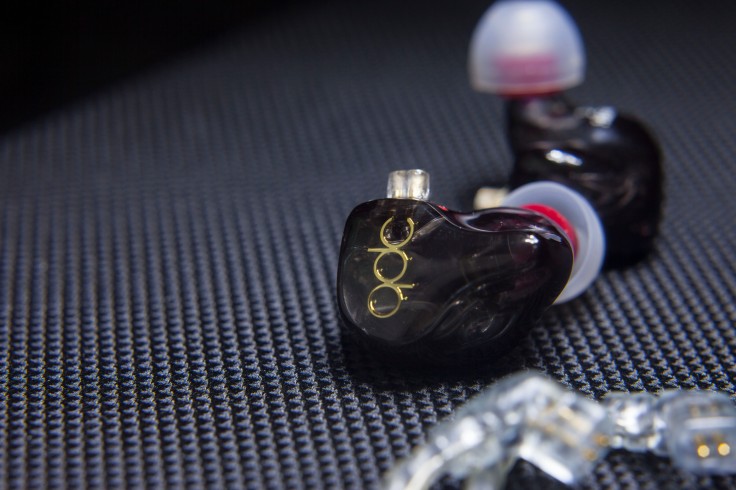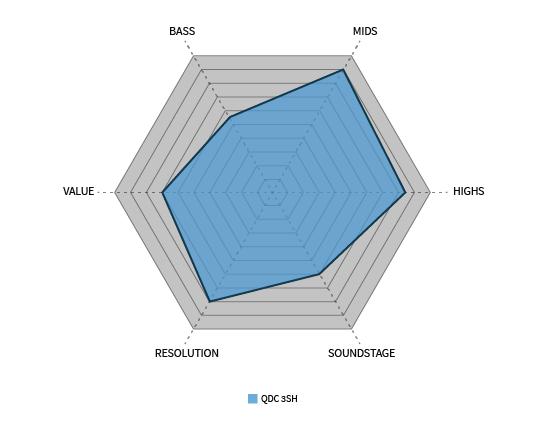 We review the qdc 3SH – a triple driver IEM that performs with exceptional sweetness and grace in the midrange frequencies.
We review the qdc 3SH – a triple driver IEM that performs with exceptional sweetness and grace in the midrange frequencies.
In my self-imposed haughtiness and superiority, I have always told Alfred and Martin that I will be the high-end reviewer for this blog, and that they should be responsible for more budget options (because I am such an egotistical, narrow-minded gear whore who equates quality solely with price). Sauntering around the corridors of the Hong Kong High-End Audio Visual Expo 2016, the AA team came across a line of ordinary looking IEMs unbeknownst to us. They all had the letters ‘qdc’ embossed on the faceplate. Without any knowledge of what they were, I absent-mindedly jammed a random qdc into my ears and randomly selected a track for testing, not thinking much of it since it was not a recognisable, price-no-object TOTL. The result was of shock and awe, as gripping vocals descended upon me and made me feel the full blunt of my folly.
Four days later I saw the qdc 3SH, 5SH, 8SH and 4SS available in a local shop’s window. I demoed them all, and the ‘Hi-Fi’ tuning (SH designation) was the most to my liking, with soaring vocals that were rendered exceedingly clear. Surprisingly, the most affordable version (3SH, with one balanced armature driver for bass, mids and highs respectively) also appealed to me the most. Any of the brand’s models can also be made as CIEMs, but universal models only came in solid glossy black, white or red. The 3SH that I picked, however, had a translucent dark smoke shell that was an unintentional (and beautiful) mistake from the factory. Feeling like a dark smoky unicorn was calling out to me, and consumed by reckless lust, I plopped down my card and bid my hard earned cash farewell. So much for snobbery.

A short summary

Pros
-Very sweet midrange focused sound with a spattering of high detail makes it ideal for vocal lovers
-“Universal-Custom” form factor makes it very comfortable to wear
Cons
-Intimate vocal and instruments tuning creates a much narrower sound stage
-Uneven build quality has SpinFit tips (and potentially other tips) more prone to slipping off at one side
-Can be restrictive in terms of suitability for different musical genres

Sparing you the pleasantries
Unlike the memorable first sound impression the 3SH gave me, the unboxing itself was a rather mundane affair. Inside a plain box was a block of hard foam containing the negative impressions for an airline adapter, a 3.5mm to 6.35mm headphone adapter, some paperwork, and a simple carrying case with two packets of double-flanged, silicone tips and the IEMs inside. Everything felt way too spartan, and the wrong kind of minimalistic: I think the word crude came to mind. If you hold a prejudicial view that Chinese products packaging often lacks that sort of shiny charm that evokes sentiments of luxury, this isn’t going to change your mind.

The earphones are constructed from simple acrylic and uses 2-pin connectors. Unimpressive physicality continued from the unboxing as I came to realize that the canals were nonuniform in diameter: the right canal seemed slimmer and the same Medium SpinFit tip (also placed on the left side) was incredibly easy to come loose on this side. In fact, I have lost over two SpinFit tips now due to their insecure placement on the right canal. Otherwise, the IEMs are moulded into a ‘custom-universal’ form factor à la InEar StageDriver, with contours shaped between a generalistic blob of a universal shell and those from a complex bespoke CIEM. Aside from the hazard of the tips falling off like that pair of low hip hop baggy pants in your youth (admit it, everyone had at least one pair), the 3SH is very comfortable.

A dream machine for vocals
But all these things hardly matter anymore when you put the 3SH on and play some tunes, especially those with human voices. The “SH” in 3SH stands for the ‘Hi-Fi’ tuning series of qdc, amongst the ‘Live’ and ‘Studio’ lines also available, and if qdc’s vision of ‘Hi-Fi’ is forward, clean, smooth vocals that soar and stimulate, then they have unequivocally succeeded.
No, this little Chinese gem is not the last word on tonal balance or reference accuracy. But damn, those mids though. Layers and heaps of honeycomb and maple syrup don’t begin to describe these incredibly lush, sweet mids. Most pop music lives and breathes in the midrange and the 3SH nails this on the head, if nothing else. These mids are elevated, astoundingly clear, airily intimate, and really really lovely. They extend and soar mightily, and the listener’s emotions are taken upwards in a melodic flight. As time went on, I felt like I was melting into an irresistible whirlpool of saccharine and when I was done, I emerged, dripping in sugar-coated goodness.

This is a front-row-center, in-a-chamber experience, with the singer whispering, or crooning, or belting out music directly into your ears. No, I’m not trying to pen a distasteful erotic novel, these IEMs are simply that romantic and comfortable. Spend some quality time with the 3SH, and you are sure to be bathed in honey. The 5SH and 8SH do layer more, but they seem to be too powerful and energetic, tipping the simple delicacy of the 3SH just over the edge, even introducing some sibilance. From Joni Mitchell’s sweet and supple performance in You Turn Me On, I’m a Radio to Emmylou Harris’s tremulous, folksy narrative through Here, There and Everywhere, it’s as if the little armatures inside pour forth their emotions from all their metallic hearts. Likewise, from Lana Del Rey’s sultry and sensuous rendition of Young and Beautiful, to the poignant and haunting vocals of Amy Lee on Evanescence’s Hello, all through to the powerful, soul-piercing head voice of Han Hong, the 3SH skillfully navigates playful falsettos to sustained tremolos, moving deftly through the vocal registers and dynamics with all the elegance, frailty, grace lay bare, and none of the little flaws in between.

I’m in a choir, not a band
Ok, so enough with the vocals raving, how do the other aspects fare?
Bass is just south of neutral, with a fast roll off from mid-bass down into the sub-bass region, and being overall slight recessed. Impact seems to be mid-bass focused, but is limp and half-hearted, so the 3SH is honestly not the most satisfying IEM for bass lovers. Dance and rock music simply fall flat on their faces without the intensity and the bass boost. When pushed to produce bass with dubstep music, it was still able to perform to an extent, but the lack of sub-bass rumble left me wanting more. The quality of the sound is still very decent, and I was able to pick out many fine details here even though this frequency range definitely takes a backseat to the vocal range. Bass transition to midrange is quite flat, no obvious dip was noticed as it transitions up to the mids like with many other IEMs.
The high frequencies don’t seem to be especially pronounced either, but judging by how there is a great sense of air in vocals and how exceptionally crispy snare drums sound, there’s probably a decent amount of 5k-10khz boost to create this sound. Highs overall seem quite neutral as well, again overshadowed by the amount of mid presence.
It is plain to hear that bass and treble are not the star of the show with the 3SH, but play more complementary and supporting roles in the emotional reproduction of the midrange.
Measurements

Alfred’s Notes: Above are measurements taken with the Vibro Veritas, an enthusiasts’ measurement rig which should not be completely relied upon outside of 100-10000Hz. The frequency response below shows the extreme neutrality and flat curve of the qdc 3SH in the bass to mid region all the way to 2kHz where many other IEMs will typically be dipping down. This largely agrees with our perceived sound of the 3SH with its boosted mid and vocal range overshadowing the other frequencies.
While I agree with Oliver’s experience in that the bass response is not the strongest around, in my testing of it I found that it did not roll off so quickly that it was “limp” (just trying to give an alternative perspective!), but it is determinedly softer than neutral.

Pincushion Distortion
Unfortunately this is not the end of the 3SH’s woes. The “double-edged sword syndrome” (term coined by yours truly) is high at work here, as all-out midrange intimacy means that everything feels incredible narrow, and sound warps and bows inward too much for their own good. Live guitars sound lovely yes, but they are pushed so forward and pronounced that it feels less natural and starts to agitate after extended listening, not to mention the soundstage is compressed and distorted. What we get here is a simple kind of give and take, forsook soundstage for surreally intimate vocals. If a perma-vocal boost EQ ever took on a form, it would look like 3SH. However, this is akin to being stuck with shooting with a 200mm telephoto, sometimes you hear a tune and wish that it’d go wider, but you can’t. The trick then, is to pick your battles well with this specialist IEM. Skip the looming orchestral stuff, and just play to the 3SH’s strengths.
Ending Remarks
Almost everyone loves cuddly, sweet affection, but everybody needs some space now and then (yes, even audiophiles), and the 3SH simply refuses to give it to you. But if you ever feel lonely and in need of human affection on a dark stormy night, and you crave the voluptuous vocals of a woman caressing your eardrums, you could do a lot worse than with a pair of qdc 3SH stuck in your ears. Behold this angelic marvel straight out of Shenzhen, succumb to the songs of its many sirens, everything else hardly matters.
1 Pingback